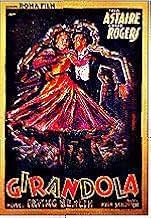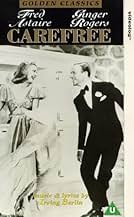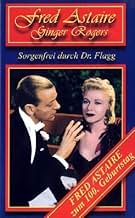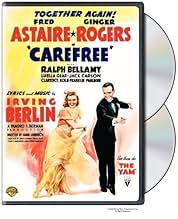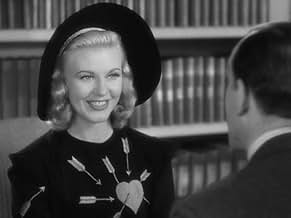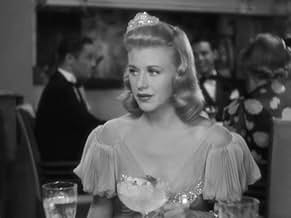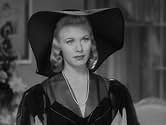AVALIAÇÃO DA IMDb
6,9/10
4,5 mil
SUA AVALIAÇÃO
Adicionar um enredo no seu idiomaA psychiatrist falls in love with the woman he's supposed to be nudging into marriage with someone else.A psychiatrist falls in love with the woman he's supposed to be nudging into marriage with someone else.A psychiatrist falls in love with the woman he's supposed to be nudging into marriage with someone else.
- Direção
- Roteiristas
- Artistas
- Indicado a 3 Oscars
- 3 vitórias e 4 indicações no total
The Robert Mitchell Boy Choir
- Vocal Ensemble
- (cenas deletadas)
- (as Robert B. Mitchell and his St. Brendan's Boys)
Harry A. Bailey
- Sponsor
- (não creditado)
Bobby Barber
- Minor Role
- (não creditado)
Cliff Bergere
- Minor Role
- (não creditado)
Ralph Brooks
- Country Club Guest
- (não creditado)
James P. Burtis
- Glass Truck Driver
- (não creditado)
Harry Campbell
- Minor Role
- (não creditado)
James Carlisle
- Country Club Guest
- (não creditado)
Charles Coleman
- Doorman
- (não creditado)
Avaliações em destaque
Hilarious and very stylish, this spellbinding art moderne musical is a real experiment in RKO craftsmanship. Did you know the dream sequences to the song "I used to be color blind" were originally filmed in color but the release abandoned because RKO couldn't get the tech specs right and the cost was going to be too high for the budget already set. It was a great idea and today might have made CAREFREE a more enduring success as there is no color footage of them as a dancing pair until 1949 at MGM.. Apart from the snazzy look of the art direction, Ginger's fantastic 'hearts and arrows' outfit and big black bewitching hat and the RKO world of the stone and timber country club, the music here is just terrific. The swing antics of the golf club bagpipe sequence had one audience I saw it with in rapturous applause. But I defy anyone to stay seated during THE YAM as they wing and swing their way all over the BIG SET Country club. CAREFREE is just great.
CAREFREE (RKO Radio, 1938), directed by Mark Sandrich, a screwball comedy set to music, reunites the song and dance team of Fred Astaire and Ginger Rogers for the eighth time in a sort of welcome change from their previous efforts: Astaire plays a doctor, psychiatrist by profession, rather than his usual lovesick American dancer, although the doctor in question DOES have a talent for dancing. Rogers, breaking away from sophisticated humor, makes her mark in broader comedy. She's been funny before, usually sassy with nifty comebacks, but this time in the dizzy-dame mode, but fortunately, not to the extreme.
The plot focuses on Stephen Arden (Ralph Bellamy), a witless attorney. He becomes drunk after his engagement to popular radio star, Amanda Cooper (Ginger Rogers), has been broken for the third time and stumbles to the Medical Foundation building to ask his good friend, Dr. Tony Flagg (Fred Astaire), a psychiatrist assisted by his white coated Connors (Jack Carson), to have Amanda "what's 'er name" analyzed. While waiting in his office, Amanda, accidentally stumbles upon Flagg's phonograph record, listening to a diagnosis about his last patient, closing with his comment about his next patient, Miss Cooper, being a "maladjusted woman." Upset, Amanda turns the tables around by sitting behind his desk and the doctor uncomfortably on the other end in a question and answer session. While bicycling in the park with Steven and her Aunt Cora (Luella Gaer), Amanda and Tony meet again, coming come to friendly terms. Agreeing to Tony's treatments, Amanda goes through a dinner special diet (lobster with mayonnaise and buttermilk) so to have her dreams analyzed, and hypnotism that turns to disaster when roaming the streets in a trance.
With plenty of comedy written into the screenplay, it's a wonder how dance numbers could fit into an overall "screwball" comedy, especially with a score by Irving Berlin. This is where CAREFREE stands apart from the other Astaire and Rogers films. The first number, "Since They Turned 'Loch Lamond' Into Swing" finds Astaire at a golf course accomplishing several things at the same time by playing the harmonica and tap dancing to a Scottish underscoring while teeing off several golf balls in rhythm, all to perfection without once missing his mark. There is no vocal to this number. "I Used to Be Color Blind" is very interesting mainly because it takes part as Rogers' dream dance, with Astaire, singing and dancing in slow motion. While "The Yam" sung by Ginger Rogers at the country club, is an upbeat number, followed by dancing with Astaire on wooden floors rather than the traditional glossy ones. It didn't become a memorable duet as "The Carioca," "The Continental" or "The Piccolino," but unlike these earlier dance numbers, which Fred and Ginger are the main focus, they invite dinner guests to join in with them. The final number, "Change Partners," a more appropriate title than "Carefree," is a beautiful love dance, or trance dance, where the hypnotized Rogers dances in a motionless manner with Astaire. While "Change Partners" is in slower tempo, it's one of the film's most memorable tune, it not, their most sentimental dance sequences. "Change Partners" earned an Academy Award nomination as Best Song.
Luella Gear, as Rogers' matron aunt, Cora, comes across as a middle-aged Kay Francis but speaking like Helen Broderick. Gear, in her movie debut, had very few films to her credit. She's reportedly best known for her role as Aunt Hortence in the stage version of THE GAY DIVORCE (1932) that starred Astaire. Ralph Bellamy, who by this time was usually type-cast as stuffy suitors, happens to be the most masculine of Rogers' rejected beaus thus far. His character, however, becomes very unlikable towards the second half, bogging down the story.
Rounding out the cast in smaller roles are Franklin Pangborn (Roland Hunter); and Hattie McDaniel (Hattie, the maid); and Kay Sutton (Miss Adams). Clarence Kolb takes support as the no-nonsense Judge Joe Travers, Stephen's friend who pleasure himself by telling corny jokes. Although credited, the Robert B. Mitchell and the St. Brendan's Boy Choir seem to have become victims of the editing process consider how they're nowhere to be seen, only heard on the soundtrack singing "Change Partners" near the film's close.
In spite of numerous pros and cons, CAREFREE ranks the team's most underrated film as shortest (83 minutes). It's occasionally funny in spots with imaginable, if not too successful, dance numbers. Other than CAREFREE being available on video cassette and DVD, and formerly found on American Movie Classics prior to 2001, it turns up occasionally (with close casting credits restored) on Turner Classic Movies. Next in the Astaire and Rogers series, THE STORY OF VERNON AND IRENE CASTLE (1939). (***)
The plot focuses on Stephen Arden (Ralph Bellamy), a witless attorney. He becomes drunk after his engagement to popular radio star, Amanda Cooper (Ginger Rogers), has been broken for the third time and stumbles to the Medical Foundation building to ask his good friend, Dr. Tony Flagg (Fred Astaire), a psychiatrist assisted by his white coated Connors (Jack Carson), to have Amanda "what's 'er name" analyzed. While waiting in his office, Amanda, accidentally stumbles upon Flagg's phonograph record, listening to a diagnosis about his last patient, closing with his comment about his next patient, Miss Cooper, being a "maladjusted woman." Upset, Amanda turns the tables around by sitting behind his desk and the doctor uncomfortably on the other end in a question and answer session. While bicycling in the park with Steven and her Aunt Cora (Luella Gaer), Amanda and Tony meet again, coming come to friendly terms. Agreeing to Tony's treatments, Amanda goes through a dinner special diet (lobster with mayonnaise and buttermilk) so to have her dreams analyzed, and hypnotism that turns to disaster when roaming the streets in a trance.
With plenty of comedy written into the screenplay, it's a wonder how dance numbers could fit into an overall "screwball" comedy, especially with a score by Irving Berlin. This is where CAREFREE stands apart from the other Astaire and Rogers films. The first number, "Since They Turned 'Loch Lamond' Into Swing" finds Astaire at a golf course accomplishing several things at the same time by playing the harmonica and tap dancing to a Scottish underscoring while teeing off several golf balls in rhythm, all to perfection without once missing his mark. There is no vocal to this number. "I Used to Be Color Blind" is very interesting mainly because it takes part as Rogers' dream dance, with Astaire, singing and dancing in slow motion. While "The Yam" sung by Ginger Rogers at the country club, is an upbeat number, followed by dancing with Astaire on wooden floors rather than the traditional glossy ones. It didn't become a memorable duet as "The Carioca," "The Continental" or "The Piccolino," but unlike these earlier dance numbers, which Fred and Ginger are the main focus, they invite dinner guests to join in with them. The final number, "Change Partners," a more appropriate title than "Carefree," is a beautiful love dance, or trance dance, where the hypnotized Rogers dances in a motionless manner with Astaire. While "Change Partners" is in slower tempo, it's one of the film's most memorable tune, it not, their most sentimental dance sequences. "Change Partners" earned an Academy Award nomination as Best Song.
Luella Gear, as Rogers' matron aunt, Cora, comes across as a middle-aged Kay Francis but speaking like Helen Broderick. Gear, in her movie debut, had very few films to her credit. She's reportedly best known for her role as Aunt Hortence in the stage version of THE GAY DIVORCE (1932) that starred Astaire. Ralph Bellamy, who by this time was usually type-cast as stuffy suitors, happens to be the most masculine of Rogers' rejected beaus thus far. His character, however, becomes very unlikable towards the second half, bogging down the story.
Rounding out the cast in smaller roles are Franklin Pangborn (Roland Hunter); and Hattie McDaniel (Hattie, the maid); and Kay Sutton (Miss Adams). Clarence Kolb takes support as the no-nonsense Judge Joe Travers, Stephen's friend who pleasure himself by telling corny jokes. Although credited, the Robert B. Mitchell and the St. Brendan's Boy Choir seem to have become victims of the editing process consider how they're nowhere to be seen, only heard on the soundtrack singing "Change Partners" near the film's close.
In spite of numerous pros and cons, CAREFREE ranks the team's most underrated film as shortest (83 minutes). It's occasionally funny in spots with imaginable, if not too successful, dance numbers. Other than CAREFREE being available on video cassette and DVD, and formerly found on American Movie Classics prior to 2001, it turns up occasionally (with close casting credits restored) on Turner Classic Movies. Next in the Astaire and Rogers series, THE STORY OF VERNON AND IRENE CASTLE (1939). (***)
Fred Astaire and Ginger Rogers star in this delightful romantic musical comedy with a twist on the usual Fred and Ginger plot. Though odd and short in the musical number department, this teasing romantic romp features some of their best dancing and good humor to boot. Ginger Rogers is nothing short of stunning in this picture and Mr. Astaire's feet never touch the ground. Definitely their most underrated film.
there is something specific about watching fred astaire and ginger rogers that just makes you want to dance. i think it's because they make it look so damn fun. and they are just so astonishingly good!! the plot here is a tad crazier than, say "top hat", and therefore that much less believable (come on ... going all out with freud and hypnosis, but then again that's just speaking from what is known today, so no problem letting that pass). irving berlin's music is a hoot at times (there's a song about yams) and classic and familiar at others ("change partners") and ginger rogers is nearly at her sassy best.
this is one of my favorite fred astaire/ginger rogers films. it's highly amusing how she toys with him at the beginning of the film, and then once he begins hypnosis, they have one of the best dance scenes i've ever seen between them. as always, their magic together is astounding.
Você sabia?
- CuriosidadesThis was the first Fred Astaire-Ginger Rogers film to lose money on its initial release. It lost $68,000 (~ $1.48M in 2024) for RKO according to studio records.
- Erros de gravaçãoAs Amanda (Ginger Rogers) exits the taxicab and starts to cross the street for the theatre, you can see the reflection of the roof line behind her in the large piece of plate glass on the truck. On the roof line, you can see the rigging pipes for lights and other equipment showing it's a back lot set.
- Citações
Stephen Arden: [drunkenly] Oh, uh, could you give me a little information?
Doorman: Yes sir.
Stephen Arden: Thank you.
[walks away]
- Cenas durante ou pós-créditosDuring opening credits, a pair of hands finger-paints names, pauses, wipes them out, and writes the next set of names several times.
- ConexõesFeatured in Fred Astaire: Puttin' on His Top Hat (1980)
- Trilhas sonorasSince They Turned Loch Lomond into Swing
(1938) (uncredited)
Music by Irving Berlin
Danced by Fred Astaire
Principais escolhas
Faça login para avaliar e ver a lista de recomendações personalizadas
- How long is Carefree?Fornecido pela Alexa
Detalhes
- Data de lançamento
- País de origem
- Idioma
- Também conhecido como
- Baila conmigo
- Locações de filme
- Empresa de produção
- Consulte mais créditos da empresa na IMDbPro
Bilheteria
- Orçamento
- US$ 1.253.000 (estimativa)
- Tempo de duração
- 1 h 23 min(83 min)
- Cor
- Proporção
- 1.37 : 1
Contribua para esta página
Sugerir uma alteração ou adicionar conteúdo ausente

